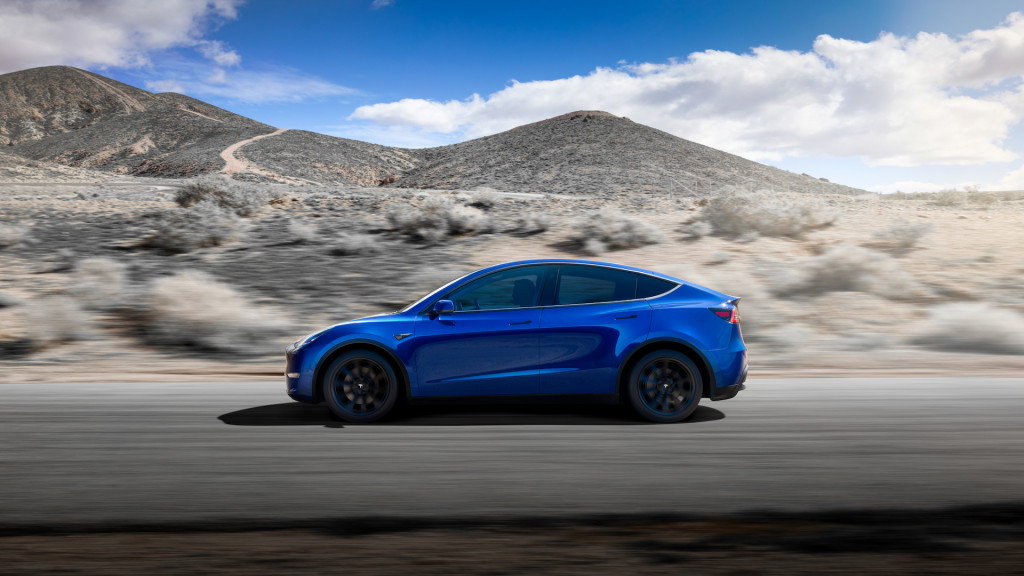Shoppers soon will have multiple fully electric options in one of the new-vehicle market’s hottest segments—the compact crossover. The Tesla Model Y and Ford Mach-E are both fundamentally the same size as popular models like the Honda CR-V or Toyota RAV4 but go without tailpipes and fuel tanks and promise to pack in a lot more excitement.
Both are due for first deliveries as soon as the middle of 2020, and we expect Ford’s first dedicated electric vehicle, the Mustang Mach-E, to reach the market very soon after that.
Ford is calling the Mach-E an SUV, even though it’s part of the Mustang family. Tesla calls the Model Y a sport utility, although because it only makes electric vehicles it’s less concerned about those designations for meeting fleet mpg averages.
Range and performance
Ford plans to designate two range and battery capacities of the Mach-E: standard range (SR) and extended range (ER). Standard range models will target an EPA-rated 230 miles with rear-wheel drive or 210 miles with all-wheel drive, while extended range rear-wheel drive models will get an estimated 300 miles of range and ER AWD versions are targeted at 270 miles.

Tesla Model Y
For the Model Y, Tesla is anticipating a 300-mile range for Long Range versions, plus the recovery of 168 miles of range in 15 minutes, via the Tesla Supercharger network. On V3 hardware, the Model Y will charge, like the Model 3, at up to 250 kw. Ford says that the Mach-E will return a range of up to 300 miles, and a DC fast charge time that recovers 47 miles in 10 minutes, on a 150-kw CCS unit.
Tesla hasn’t specified power and torque ratings for the Model Y lineup, but its 0-60 mph times range from 5.9 seconds for base Standard Range versions up to 4.8 seconds with Dual Motor AWD and 3.5 seconds for Performance versions. Power, torque, and acceleration claims will also vary by version for the Mach-E, with standard range models making 255 hp while extended range versions make 333 hp and 429 lb-ft. Variants of the Mach-E may vary in acceleration times from the mid-3-second range to the mid-5-second range.
Features and pricing
Pricing between the Model Y and Mach-E will be surprisingly close. Base Select versions of the Mach-E start at $43,895 (plus destination) and will accelerate to 60 mph in the “mid 5-second” range, according to information posted by Ford, and will range up to $60,500. Tesla has said that the cost of the Model Y Standard Range will be as low as $39,000 (or $40,200 using its current $1,200 destination), with the Long Range at around $48,200 and the Performance model above that. Buyers of the Mach-E will be eligible for the full $7,500 EV tax credit, whereas the credit will likely have expired completely for Tesla before Model Y deliveries start.

2021 Ford Mustang Mach-E leak
The Tesla Model Y will closely parallel the Model 3 sedan for features. It has the same entry and control system that, as with the Model 3, requires no keys and is smartphone based, allowing you to simply walk away without worrying about shutting the vehicle down. The Tesla Model Y comes with a suite of 12 ultrasonic sensors and a 160-meter forward radar system—part of Tesla’s Autopilot suite—and buyers can opt for Full Self Driving, which adds features like the much-hyped Smart Summon. CEO Elon Musk has said that by the time the Model Y is launched Full Self Driving will be “feature-complete,” meaning the software will be in place allowing the vehicle to perform an expanded range of automated functions.
Styling and space
Both models are about the same size and have similarly abbreviated coupe-like rooflines, but they make different decisions about how space should be prioritized—and, perhaps, how much space is to be sacrificed for styling. The Model Y is essentially a tall-roof version of the Model 3, and its exterior was designed to be clean and simple. It’s a no-drama design that looks sleek and sporty from a few steps back.
Based on early pictures, the Mach-E follows a different approach. It looks all Mustang, with a coupe-like roofline, flared rear fenders, and a well-sculpted body that packs in a lot of expression with creasing and curves. The blacked-out accents and three upright rear lights make clear that this is part of the Mustang family, while the front appearance, with a flush piece in place of a grille, showcases that there’s not an internal combustion engine under the hood.

2021 Ford Mustang Mach-E leak
Inside, the Mustang has a large vertically oriented touch screen, plus a smaller thin, horizontally oriented gauge “screen.” The dash looks low and clean, with climate vents pressed into a thin horizontal beltline and few other buttons or controls.

Tesla Model Y
The interior of the Model Y has been borrowed directly from the Model 3 (the two share about 75 percent of their parts, and a glance inside really underscores that), so expect the same very simple interior—either charmingly simple or stark and drab, depending on how you see it—perhaps accented with a few new materials. Based on how Ford has set its proportions versus how Tesla has, we expect the Mach-E to have a little less rear seating space than the Tesla—and the preliminary cargo space rating of 59.6 cubic feet for the Mach-E vs. 66 cubic feet for the Model Y might just confirm that.
Full specs for both vehicles haven’t yet been released and are being teased out in small pieces. We’ll update this with more as details emerge.
